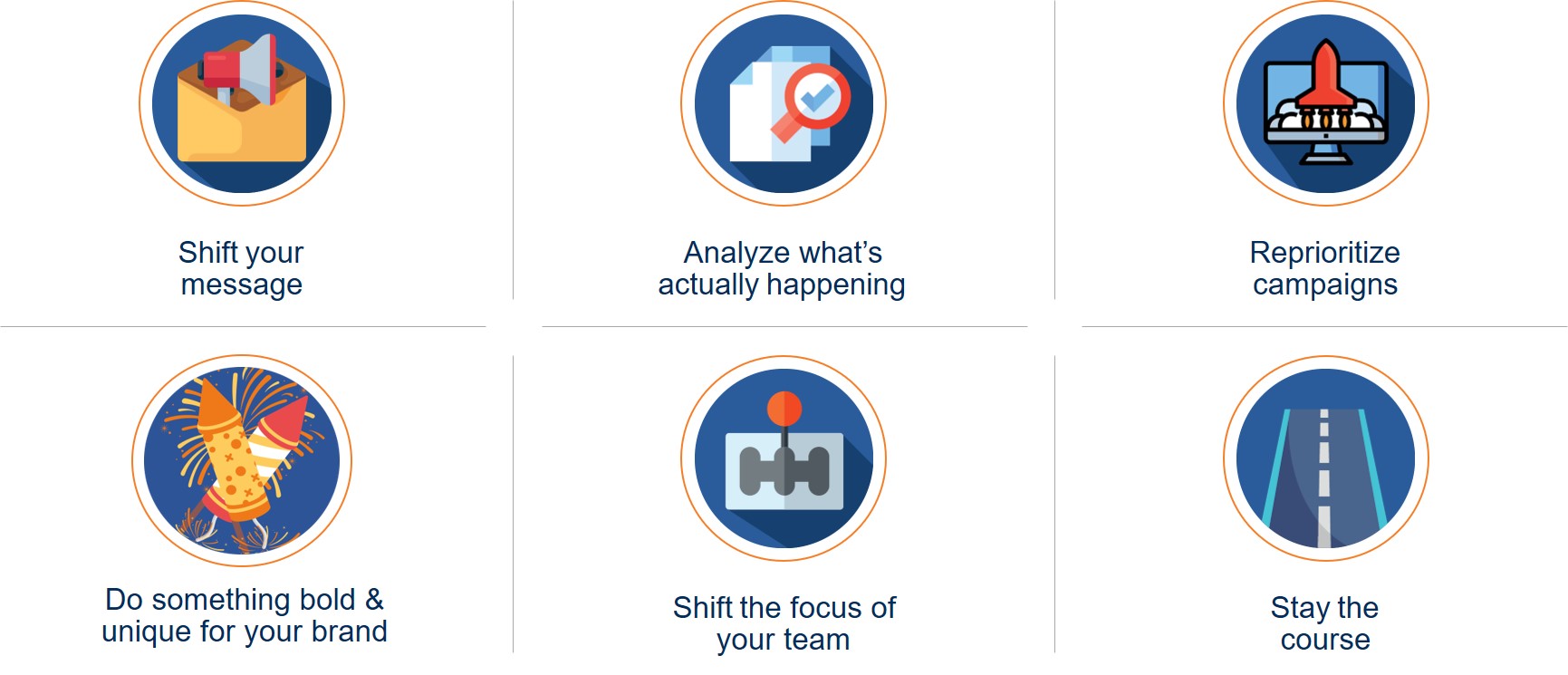6 Ways B2B Companies Are Adjusting Their Marketing & Lead Generation

The world has changed, and you're thinking about how to change your marketing and lead generation plans to ensure success in the months ahead.Over the last few weeks, the team at Mezzanine has talked with sales and marketing leaders in B2B companies across North America and with our own clients. From those conversations, here are 6 practical and immediate ways that they're changing their plans, and you should consider too.
The Current Situation
Are you feeling like this:

For many marketers, website traffic is down, inbound leads are down, and business development reps aren’t connecting with prospects. All of that adds up to reduced MQLs (marketing qualified leads). But many companies and marketing leaders haven’t had a change in their KPI targets.
So the question is, now what?
6 Practical and Immediate Changes to Consider
B2B marketing experts are using these 6 principles to pivot their marketing and lead generation plans:

1. Shift Your Message
When it comes to shifting your message, there are a few things to consider.
First, let’s assume that you’ve already done the ‘how we’re handling Covid-19’ messages to your stakeholders, and you’ve covered the 2 key components, which are what your business continuity plans are, and how you’re handling the health and well-being of your staff.
Second, what’s important right now is to be nimble in your messaging. The COVID crisis is evolving quickly, and messages are changing to match what’s happening and what’s being felt in society, in the economy, in the rules and regulations that we’re living by.
We’re seeing messages evolve in thematic ways. The first two weeks of the crisis was a Reassurance message. Then it evolved to a ‘We’re in this together’ message. Lately it’s been a message around 'Thanks To Our Essential and Healthcare Workers' message.
Next week, it will be something else, we just don’t know what it is yet.
What’s important is that you’re constantly assessing what your stakeholders need to hear from you, what you want to say, and are adjusting accordingly.
Third, make sure to revisit your automated marketing messages if you use an automated marketing platform like Hubspot or Pardot. Chances are you have a lot of automated email messages going out in sequences based on actions your prospects took in the first part of this year or last year. Those messages are probably not effective or might even be inappropriate for the current environment. Go back and check what you’re sending out through your automated system.
And lastly, you may be wondering if you can or should proceed with your pre-pandemic initiatives - the projects, campaigns and topics that you had planned before the world changed in March.
The answer to this is yes, as long as it’s relevant and appropriate (ie not totally out of touch with the current world situation) AND you acknowledge what’s going on.
There’s a good example of acknowledging what’s going on from a podcast last month called Choiceology. In the first 60 seconds of the podcast, the host Katy Milkman describes how everyone who produces the show has been working from home and doing what they’re supposed to be doing, how they’re grateful to the healthcare workers, and how they decided to continue with their planned topics for the podcast as a way to provide some entertainment and non-COVID news and content because they understood that there’s an onslaught of troubling and difficult news, and people might be hungry for something else. Listen to the first 60 seconds to get a sense of how to handle that message.
2. Analyze What’s Really Happening In Your Business
It’s easy to get caught up in the difficult news that we hear everyday and to become despondent or lament the future. But the reality is that some companies and some products will do well through this crisis. Don’t make assumptions that everything is down. Evaluate your specific business situation.
There are two ways you can do this.
The first is to look at your data. What is going on with your website? What is Google Analytics telling you? Are the search volumes for some of your keywords up while others are down? If so, turn the tap off on the ones that are low and double down on the ones that are up. Work on the webpages that are optimized for your strong keywords. Consider creating special offers for emerging, new and growing needs.
The second way to figure out if you have specific opportunities is to have your sales team do a customer calls blitz. In a 48-hour period, have your sales team connect with 10 current or past customers to talk about their business and hear what’s going on for them. These conversations will help them identify possible opportunities. Are customers looking for particular solutions based on what’s going on with their business? They may even make suggestions to you about services that would be helpful to them.
The other benefit from these calls is that it will give your sales leadership more real-time customer insight and ability to make better forecasts and navigate the upcoming quarter.
3. Reprioritize Campaigns
Your 2020 plan now feels woefully off the mark. The world has changed, at least for now. So, re-align your campaigns to the current situation. Have a look at the market segments, the solutions and the offers that you had planned for your campaigns, and reprioritize them for whatever has the highest potential and the highest need right now.
You may have opportunities in industries that you were planning on targeting in Q4. Move those up to Q2. You may have been planning to secure a number of large contracts in Q2 – it may be difficult to get those contracts signed in some sectors right now. Perhaps some customers are going to be interested in service contracts to help them maintain uptime in the coming months and avoid employee shortages or failing to have sufficient back up capacity. Look at each of your campaigns based on the market segment and the solution you were offering, and shift things around based on current information.
The good news when it comes to campaigns is that there is a communications bright spot: webinars. People are actually attending webinars. You can put webinars on in short order – just 2 or 3 days notice, and you can get great attendance. The message with your webinars needs to be helpful. This is about providing best practices, guidance and resources for your community – not hard selling.
A small detail to think about with webinars. Try to compartmentalize the COVID 19 messaging. Webinars are a great lead generation tool and you want to be able to use them in the future. But if COVID messaging is woven throughout your webinar, it won’t be appropriate once the pandemic is in the past and – hopefully – a distant memory. That won’t be possible with some of the webinars you might put out, but at least consider how you might edit the webinar and make it still useful and appropriate in 6 months.
For your business development reps who may be having a hard time getting through to prospects, consider having them reconnect with the ‘Lost / No Decision’ category of your CRM. The purpose of reconnecting is not to sell, but to offer helpful resources and support. Now is a good opportunity to talk with people that already know your company (although they may have forgotten it since you last talked with them) and offer something helpful.
Lastly, many sales and marketing professionals are wondering about Special Offers. Should you do some kind of promotion now, or would that be shameful and fall flat?
What we’ve seen is that special offers, in the right spirit and in the right tone, can be effective. Now is not the time to think about profiting from a crisis. We all remember the story about the guy who bought 17,000 bottles of hand sanitizer thinking that he could sell them on Amazon. Not only did he get shut down by Amazon but he is being investigated for price gouging.
But with the right messaging in the right offer, specials are good now. For example, Poppin (a company that sells office furniture and supplies) sent an email with a 40% off deal. They stated early in the message that their intention was not to profit from the situation, but to help people get set up and deal well with working at home. We think they landed this well.
4. Do Something Bold and Unprecedented For Your Brand
Let’s find some light and some positive in the current situation.
There is the opportunity now to do something unprecedented and bold for your company’s reputation and brand, while doing something very good for the world. There are many good examples already – we’ve seen Canada Goose manufacturing scrubs, alcohol makers producing hand sanitizer and UberEats waiving deliver fees for independent restaurants. Those are just a few examples.
There are so many creative ways you can break through the noise now, and do something that is great for your community AND also will contribute to your company’s positive reputation.
For inspiration, have a look at 50 Ways Companies Are Giving Back During The Pandemic. There are big and small ideas there. Turn to your team for their ideas. It will productively use their minds right now, and give them something positive and optimistic to think about and work on.
5. Focus Your Team
Marketing leaders are concerned about their teams. They often have young staff members who haven’t been through a downturn, and they often work with freelancers who don’t know where their next paycheque will come from.
Marketing leaders are doing a couple of things to help their people stay focused and productive.
The first thing is that they’re using this time to get prepared for later in the year. Use your resources – and this can mean your contractors and freelancers as well as employees – to prepare content, collateral and lists that you’ll use later in the year. All those case studies, whitepapers and blogs you say you want to develop but never seem to have the time to? Now’s the time.
Same thing with prospect and target lists – do all the research now so you can hit the ground running later in the year and make up for lost time.
Second, now is a great time for your team members to get certified and learn new technologies and tools. Here are 3 resources that are free or inexpensive:
1. HubSpot Academy - hours and hours of smart videos and training for digital marketing.
2. MECLabs Institute – the world’s largest independent research institute on how people make choices – which is very useful in strategic marketing and demand and lead generation
3. MasterClass – broader in nature as it isn’t just business training, it’s covers everything from cooking to interior design to negotiations. Lots of interesting teachers and subjects there.
6. Stay The Course
This might be the most important principle of all.
The data is entirely consistent over the last 100 years: companies who maintain or increase their market presence through a downturn grow disproportionately faster and larger after the downturn than competitors who cut.
A couple of specific studies that are B2B specific to help you make this case:
- McGraw Hill did a study of 600 B2B companies after the 1980s recession. Those who maintained or increased advertising through the recession grew 275% more than their peers who had decreased through the recession.
- Harris Interactive did a study of 500 B2B companies in 2001. It indicated that 86% of B2B executives reported that when they had seen a company advertise in the down economy, those companies were top of mind when it came time to make purchase decisions after the downturn.
There is data from 100 years of economic cycles (including recessions) that make this point.
If you can - and each business has to evaluate its own situation - maintain or increase your market presence now, you will be stronger and grow faster on the other side of the crisis.
Summary
For many marketers, this is the first significant economic downturn they’ve experienced. And for many more of us – the vast majority – this is the first global pandemic of our careers. No one knows exactly how long this situation will be or exactly how it will turn out. But, we hope these 6 tips will help you navigate through and be successful.
.png?width=2361&height=488&name=Mezzanine%20Logo_Horiz_RGB_on%20blue%20(1).png)
